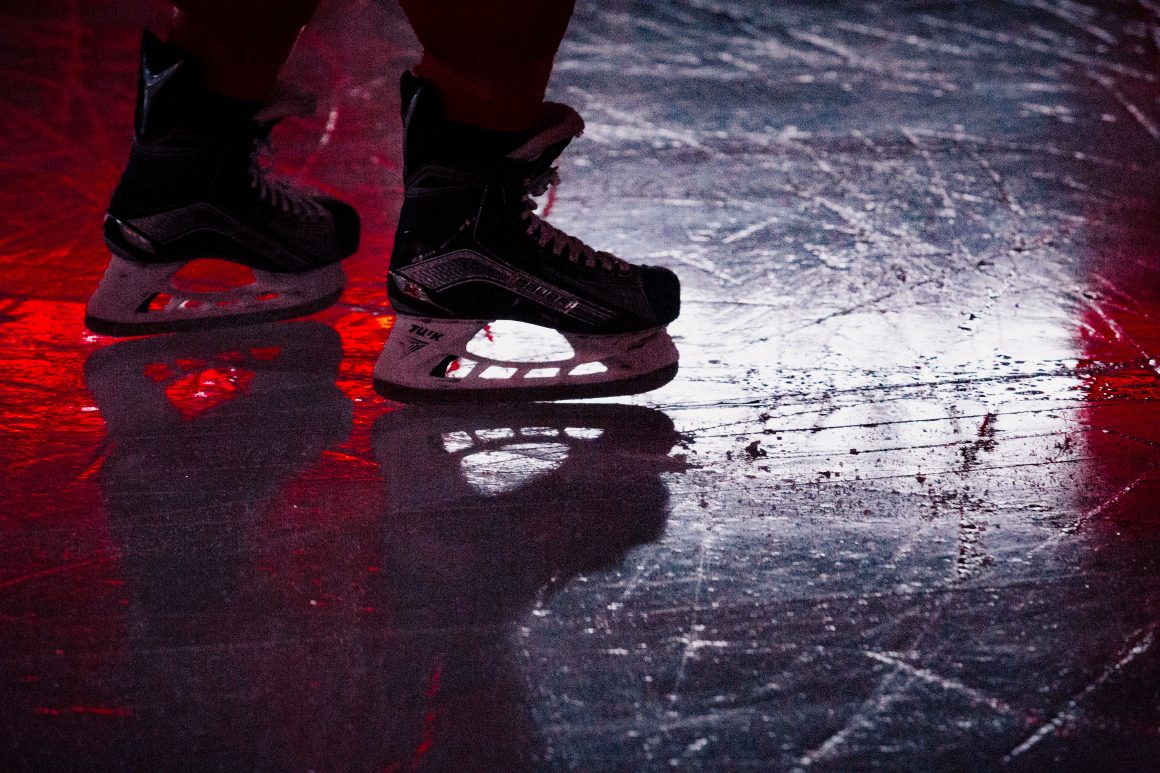
Alone in the dark: The effects of concussions on Canada’s greatest game
By Emilie Medland-Marchen, April 25 2017 —
[dropcap style=”normal”]I[/dropcap] was 12 years old when my brother Daniel was drafted to the Western Hockey League. After playing minor league hockey in Kelowna, British Columbia for years, he became a member of the Kamloops Blazers when he was still a teenager.
It was a major moment for my family. My parents and I were ecstatic. We were all proud of my brother and what he had accomplished. Like many Canadian families, we were convinced he was one step closer towards “making it” as a professional hockey player. We had invested thousands of dollars into the top development programs for junior hockey players in western Canada. We had moved from small-town Kitimat, B.C. to Vancouver Island and then mainland Kelowna in pursuit of top coaches. The image and smell of my brother’s hockey gear littered across the floor of our basement was a permanent fixture of my childhood.
The excitement started to fade when I realized that my brother, at 16, would be moving away to live with a billet family while he played in the WHL. I was too young to really understand what that meant for our relationship — as a teen, he was removed from my life for the next four years. I only saw him occasionally, when my parents and I would make road trips to visit him on the days he was allowed off from training. Most of the time, holidays were spent apart.
My memories of this time are fuzzy and scarce. They’re mostly shaped by images of my parents rather than my brother. Them weeping when he was expected to train and we weren’t allowed to spend Thanksgiving together. The drive home from Prince George after my brother was traded to the Prince George Cougars. The feeling of my mom’s nails digging into the palm of my hand, tense and frantic when we saw him drop the gloves.
But there is one persistent memory that I can’t seem to shake — the one where my parents and I knock on the door and enter a pitch-black, unfamiliar hotel room. My brother’s broken voice calling to us from the bed. Drawn curtains and a TV turned off. My mom, sitting on the edge of the duvet, tears in her eyes as she places a loving hand on my brother’s head. He complains of headaches and dizziness as we stand there, unable to help him.
The treatment at the time for minor league hockey players who had suffered a concussion was to sit alone, in a dark room. There is nothing to do but fall in and out of wakefulness, stare into the darkness and wait for it to pass.
[hr gap=”30″]
[dropcap style=”normal”]A[/dropcap] lawsuit by 10 former National Hockey League players was launched in 2013 after players claimed the NHL hadn’t done enough to protect players from concussions. Lawsuits extended into major junior hockey in 2014 when Barrie Colts goalie John Chartrand sued his former team for $12 million. He claimed the team’s medical staff and officials cleared him to play days after a violent car accident in which he suffered a concussion and lost consciousness. Meanwhile, the Canadian Hockey League — which includes the WHL — has also faced multiple concussion lawsuits for damages and neglect from players who previously played for the league.
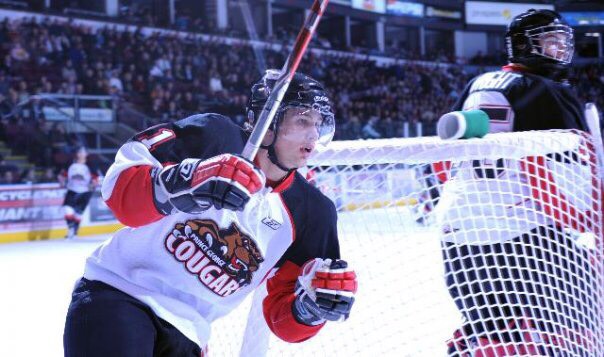
My brother, Daniel Medland-Marchen, played in the WHL for the Prince George Cougars.
While leagues face lawsuits from all sides, Hockey Canada is attempting to address concussions by promoting light-hearted educational programs. The organization developed an app to help parents, coaches and volunteers recognize concussion symptoms featuring a cartoon bear named Puckster. On their website, Hockey Canada claims that they have “worked hard to eliminate head contact from the game” and that “injuries to the brain are characterized by an altered state of consciousness.”
However, current research shows that an altered state of consciousness is not the only symptom present when a concussion has occurred. Research also shows that concussions are often unreported within hockey’s lower leagues.
The NHL has responded in a similar way. While NHL commissioner Gary Bettman claims that “the league has taken tremendous strides and put a great deal of effort and time and money into dealing with the issue of player safety, in general, and concussions, specifically,” the lawsuit against the league alleges that the NHL continues to contribute to head injuries by refusing to ban fighting and body-checking and by teams continuing to employ “enforcers” whose main job is to fight or check opponents.
Fans contribute to the culture surrounding fighting and concussions as well. The prevalence of websites like hockeyfights.com, where fans post videos of hockey fights promotes a culture of violence and features players as young as 15. On the popular Reddit hockey forums, fans complain about referees’ hesitation to allow players to fight in recent years. While it’s true that fighting has declined in the big leagues, fans constantly debate whether or not this is the right direction for the game. Traditionalists argue that the physical aspects of hockey are vital to its culture, while others support the move to limit fighting in an attempt to prevent head-related injuries. Despite these conversations, the NHL has yet to ban fighting outright.
Steve Montador, a former NHL defenseman and Calgary Flames player, died from concussion-related symptoms in February 2015. His brain was later studied in an autopsy by researchers who discovered he had Chronic Traumatic Encephalopathy (CTE), a degenerative brain disease linked to repeated blows to the head.
But we only hear the accounts of players who make headlines. There are many former players who suffer alone, either neglected by their teams at the onset of concussion or from years of repeated head injuries whose symptoms only show up decades later.
[hr gap=”30″]
[dropcap style=”normal”]M[/dropcap]y brother suffered four major concussions while playing in the WHL. It’s been seven years since he quit the sport, but that number has since climbed to eight. For players like him, that’s just the reality of the game.
“With regards to taking that step up, getting that pay and making it all the way to the professional leagues — you’re kind of going to do whatever it takes,” he said. “From a young age, Canadian hockey players are fed what I think is a lie — that they’re going to make it to the NHL. And I think that statistically, this is just not true. If you take that into consideration and the competition level of the WHL and the Ontario Hockey League, you get the understanding that these guys who are willing to make it through and put it all on the line will do anything. I was pushed beyond my limits in terms of concussions. I was pushed to come back sooner and I felt that I needed to be on the ice. And taking time away from training and away from the ice was dollars out of the pockets of those teams.”
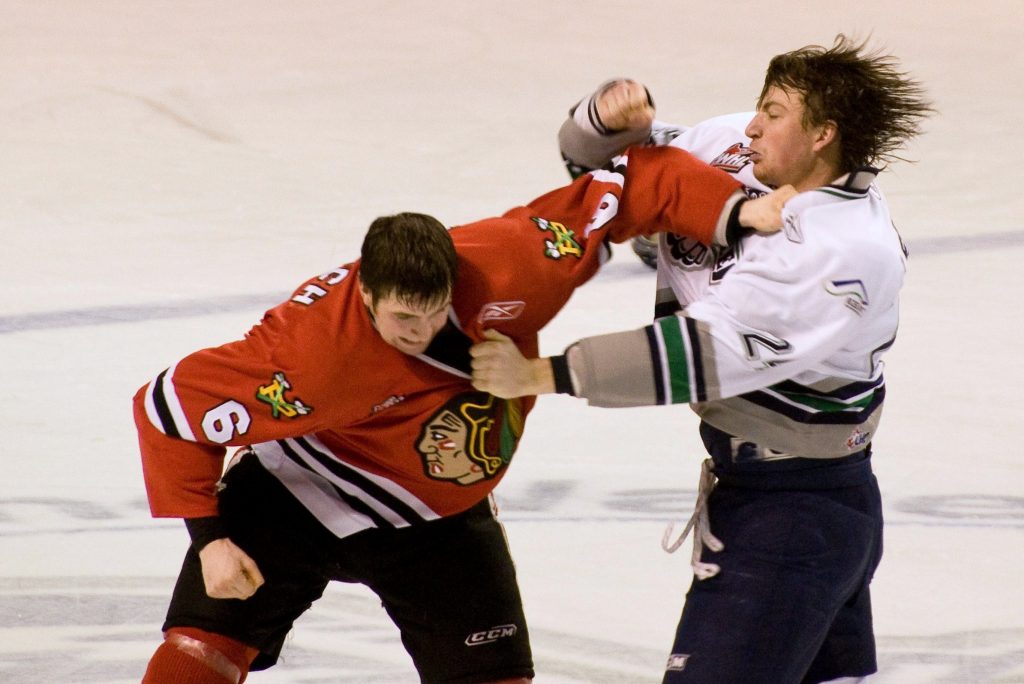
Photo courtesy Art Brom
Research has shown that people who have suffered from concussions are more likely to get them again. My brother was skiing in northern B.C. in late 2016 when he fell and hit his head. He knew the symptoms as soon as they started — dizziness, impaired memory and an inability to concentrate.
He was familiar with the recovery process for this kind of injury. He’d been through it many times before. What he wasn’t prepared for was his difficulty going back to school, where persistent memory lapses and impaired concentration led him to struggle with classes.
But luckily, his return to Calgary put him in one of the best places in the country to undergo concussion treatment. At the University of Calgary, the Sport Injury and Prevention Research Centre is one of nine research centres worldwide supported by the International Olympic Committee. Within the Sport Medicine Centre, the Acute Sport Concussion Clinic is conducting ongoing research on the prevalence of concussions in sport.
Kathryn Schneider is an assistant professor and clinician scientist at the centre. She is currently conducting research on the role of the neck and the vestibular balance system in youth athletes as part of a longitudinal study on the effect of concussions in athletes.
“One of our cohort studies is being led by Dr. Carolyn Emery and it’s called Safe to Play,” Schneider said. “It’s a five-year prospective cohort study, which is basically a study where we follow people forward in time. [We follow] ice hockey players that are 11 to 17 years of age and we’re looking at different factors that increase risk of injury. We are also looking at the best tests and measures to help when a concussion has occurred, who is at greatest risk and how we can measure recovery from concussion.”
Emery and Schneider’s research has identified that when a league allows body-checking, there is a nearly four times greater risk of concussion among athletes. It has also shown that male youth hockey players aged 11–14 are at a greater risk of concussions if they report that they have dizziness, neck pain or headache at the start of the season.
“At the time of a concussion, there is force transmitted to the head,” Schneider said. “It can be a direct blow or transmission of force through the body. A variety of different symptoms occur, the most common of which are headache, typically followed by dizziness. But there are other symptoms that can occur as well, which include difficulty concentrating, difficulty with memory, sleep, irritability and some individuals also have neck pain. Sometimes the symptoms don’t arrive right away, but they can come after time.”
Schneider says that one of the current problems with underreporting concussions is the lack of an accurate baseline test to determine symptoms. Through Hockey Canada and similar programs, most coaches are trained to conduct concussion testing themselves, through methods like holding up fingers to test for blurred vision and asking athletes their name and address to test memory.
But cultural aspects of sport can skew the results of diagnostic tests. Players often face pressure from coaches and parents to return to the ice following a blow to the head. After a concussion has occurred, returning to sport immediately without rest can cause further brain injury, worsen symptoms and increase recovery time.
It’s difficult to produce overarching data that can apply to individual concussion cases, and even harder to prove that underreporting and pressure to play are problems. But the lawsuits from former players aimed towards minor leagues suggest that hockey players face cultural pressures to play before they are ready. They suggest that hockey players face pressure to maintain a level of perceived cultural masculinity — or to just “suck it up.”
“The last concussion I had in hockey was a fight,” my brother said. “I honestly don’t remember a whole lot — I think a lot of those things have sort of been lost. What I do remember is feeling that it wasn’t okay that I had a concussion, or it wasn’t okay that I was hurt. I remember asking myself, ‘Should I go back out there? Should I keep playing?’ There was no specific person or coach or trainer that said that to me, but it very much felt that way. It did not feel like it was okay that I had a problem. I took all my gear off and I sat on the bus alone, no monitor, nobody there to check up on me or see what was going on, nobody watching to see if my situation declined. It was a very lonely time.”
[hr gap=”30″]
[dropcap style=”normal”]T[/dropcap]he approach to concussion management and reporting in hockey extends beyond the medical realm. To address the socio-cultural elements of concussion underreporting in sport, Schneider is working with U of C kinesiology professor William Bridel, whose research specializes in gender and sport.
While only in the beginning phase of their research, Bridel has noticed there are social pressures placed upon hockey players to maintain perceptions of masculinity and performativity.
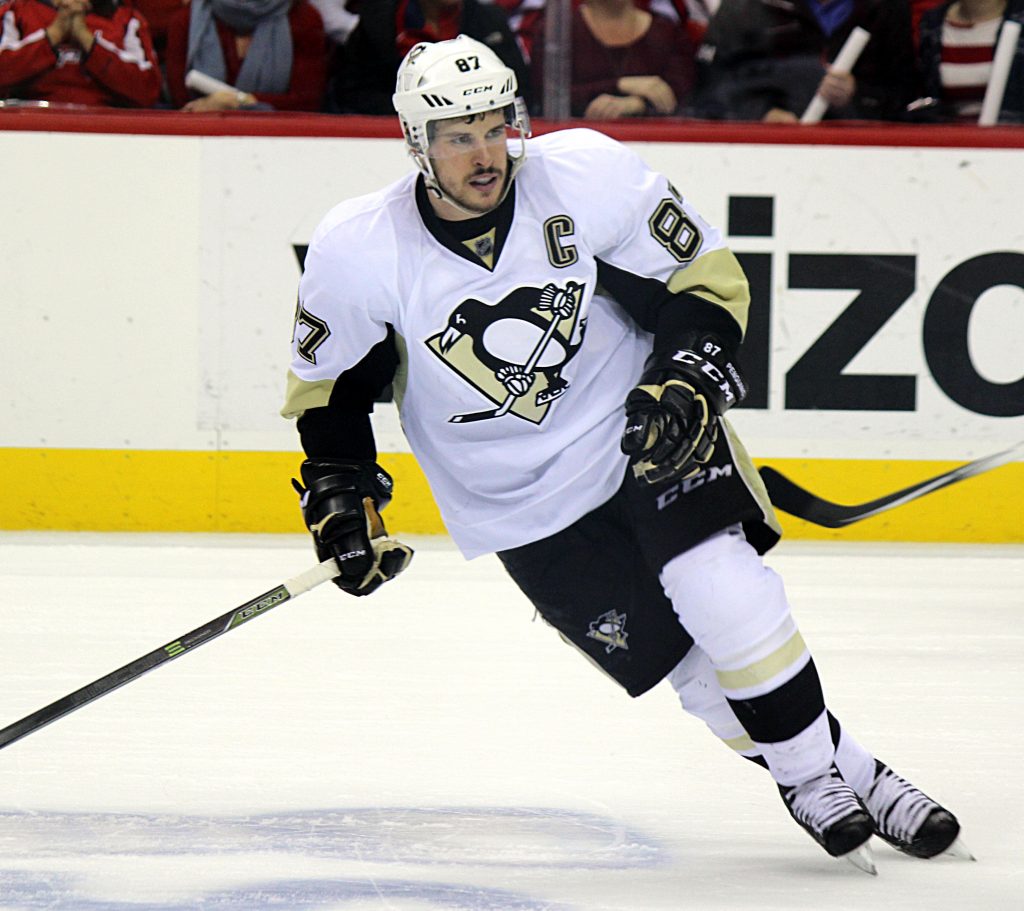
Sidney Crosby has suffered a number of concussions. // Photo courtesy Michael Miller.
“It’s a new line of research that is stemming from my long-standing interest in sport-related pain and injury,” Bridel said. “Since I came to the U of C two and a half years ago, I recognized that in our faculty there is a significant focus on concussion. The conversation started fairly quickly about adding a qualitative research component to research that is already happening, but also analyzing the socio-cultural aspect of concussion — stigma, masculinity and the culture of sport more generally.”
Bridel’s interest in head injury and perceptions of masculinity in hockey started when star Pittsburgh Penguins centre Sidney Crosby suffered his first concussion in January 2011. His recovery process was widely publicized and he eventually returned to the ice after nearly eight months in and out of training.
“It really struck me as a very interesting conversation that was unfolding around Sidney Crosby,” Bridel said. “And that was even before I came here. There was this sort of dual narrative around Crosby at the time — the first was that it was interesting in the sport of hockey that he was given the time that he needed to recover before returning to the ice. His team was obviously very supportive and understanding. Now you can unpack that a lot — he’s a star player. So if it was someone who doesn’t have that star quality, would they have been treated in the same way?”
In the case of Crosby, Bridel said he noticed a difference between fans who were supportive of his time off and fans who wanted him to return to the ice as soon as possible.
“There was almost an even split in perceptions of Crosby. Half were, ‘this is really amazing that he’s being given the time to heal and it’s really important’. And the other narrative was polar opposite. It was like, ‘he’s such a pussy. Get back on the ice. Suck it up’. It’s a masculine sport, so you know the narrative.”
Bridel has noticed this masculine culture extends beyond just hockey and other contact sports. Fan culture promotes an idea of heroism in the tradition of clapping after athletes pick themselves up off the ice. There is a tendency to promote physical toughness in athletics that leads coaches, parents and fans to misdiagnose pain and not take it seriously.
“I went through a period where I definitely felt that I was being put in a role that was kind of different from what I had grown up as,” my brother said. “Before, I was sort of a puck-moving power play defenseman. Making the jump up, I suddenly found myself thrust into grinder-type situations, or more physical types of situations. I think I responded to those pressures and started to fight quite a bit. I can remember being strongly encouraged by other members of the team to fight a particular guy. It’s hard, you know, everyone’s kind of jeering at you, yelling at you to do something.”
The tradition of lionizing athletes in the media creates a stigma amongst athletes about reporting their pain. This can extend beyond physical ailments like concussion and injury and into the realm of mental health. The list of former NHL enforcers who have ended their lives grows longer every year.
CTE, one of the most serious complications of concussions can occur as a result of multiple head traumas. Repeated trauma triggers progressive degeneration of the brain tissue and the build-up of abnormal proteins. The symptoms list is horrifying — memory loss, confusion, impaired judgment, impulse control problems, aggression, depression and eventually, progressive dementia.
There is currently no way to diagnose CTE in patients without analyzing the brain post-death in an autopsy.
Post-concussive symptoms like depression and anxiety are limited areas of research. Not many studies have examined the long-term cognitive effects of brain trauma on athletes.
Bridel thinks there has been a reluctance to engage in this branch of research because of a broader stigmatization of mental health in our society.
“Talking openly about mental health and being encouraged to talk openly about mental health is a really new idea,” Bridel said. “It’s part of a larger conversation about mental health and the stigmas that we unfortunately and tragically connect to it that just needs to be broken down further still.”
[hr gap=”30″]
[dropcap style=”normal”]B[/dropcap]ridel mentioned that hockey is part of the “cultural fabric” of Canada, and he’s right. On weekends we crowd around the TV to watch our favourite teams play in the NHL. Most of us have the Hockey Night in Canada theme song memorized by heart. Parents want their kids to be NHL stars.
There have been major drops in youth participation in other contact sports. Between 2010 and 2015 there was a 27.7 per cent drop in football participation rates from youth aged 6–14 in America. Parents are reluctant to sign their kids up for a sport where the average lifespan of a pro player is less than 60 years.
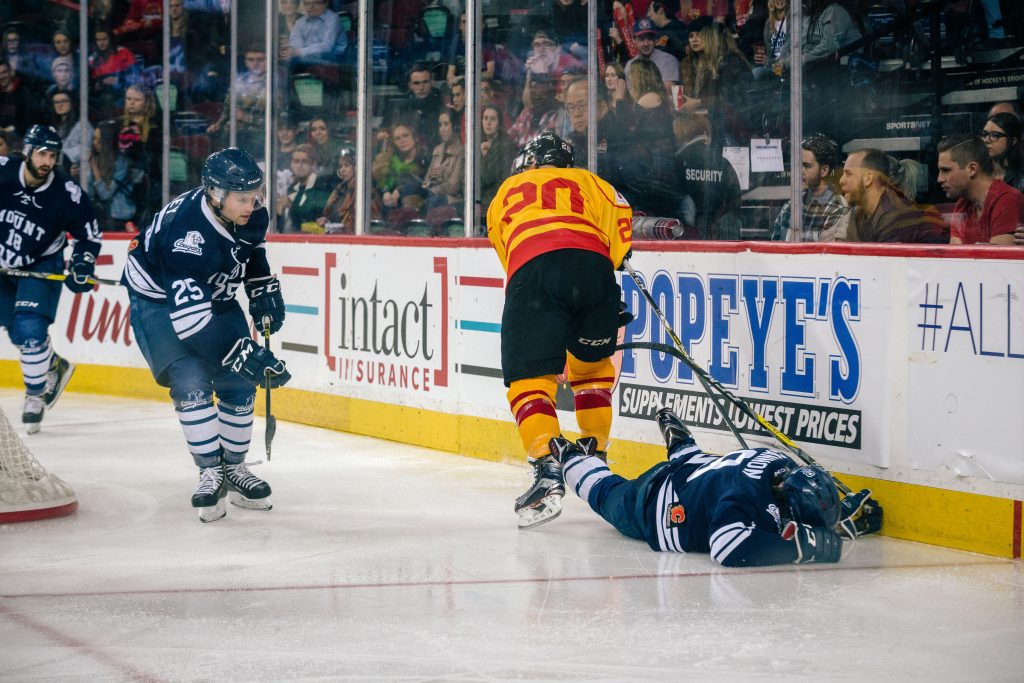
Photo by Justin Quaintance
Hockey Canada has felt a similar pressure from waning participation. When Hockey Canada and Bauer Hockey Inc. led an independent survey of 875 non-hockey playing families in Ontario and Nova Scotia in 2012, they found that the top three concerns were fun, time commitment and safety.
The organization’s newest concussion information and safety apps and their recent approval of reduced ice surfaces for younger skaters might be an attempt to address these concerns.
The fact remains that most players who strap on skates will never play in the NHL. The road to get there is paved with obstacles — removal from family, friends and hometown at a critical age of development, a ‘play or be traded’ mentality prevalent in the lower leagues and a desire to maintain a fragile perception of masculinity. Even without all this cultural baggage, there are still the muddy and relatively unknown long-term consequences of repeat head injuries.
But is it worth it, for a shot to one day play in the big leagues?
“I took a lot out of hockey. I learned a lot of leadership skills, I learned a lot of how to work with a team and a lot about myself. But no, I wouldn’t do it over again. I was quite talented in a multitude of sports as a child and I would have chosen the sports that had less contact,” my brother said. “Parents need to understand that it’s not just the Canadian dream — it’s their kids’ life and their kids’ brain and they need to have a life beyond the ice.”
In some ways, my recollection of that time in my brother’s life reflects the symptoms of concussion — faded memories, confusion and complicated emotional trauma, all from the memory of my brother sitting there, alone, in a dark room.
